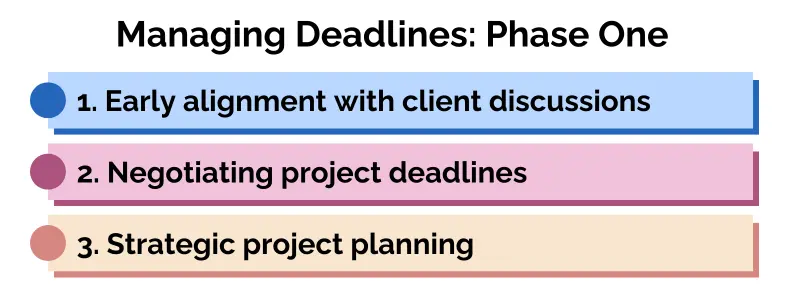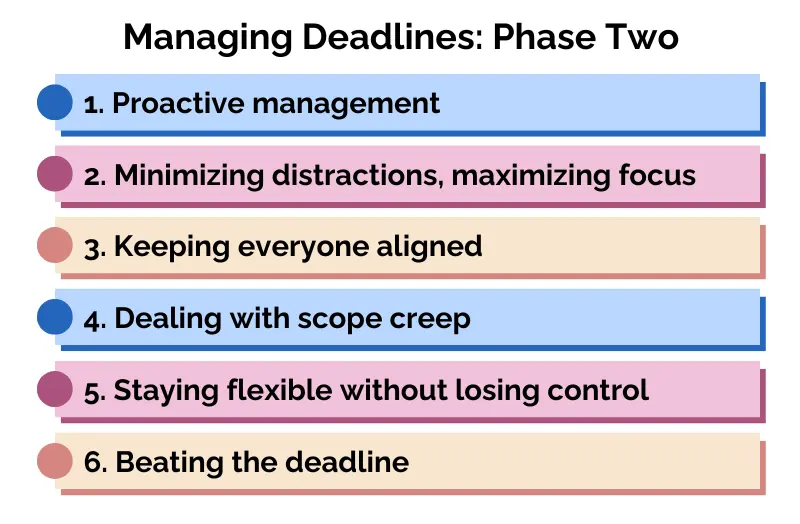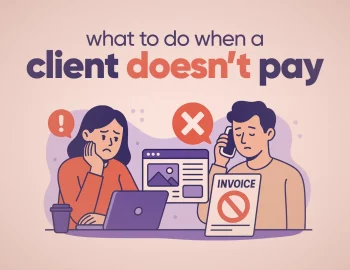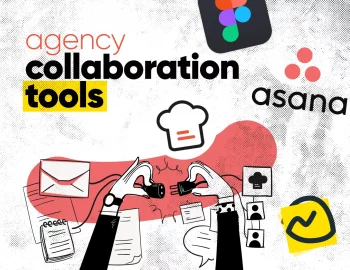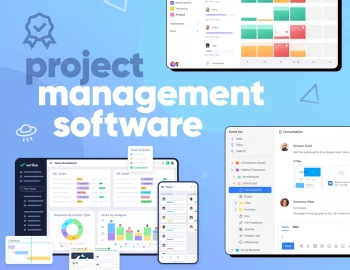Deadlines – they can be the best motivators or the ultimate stress inducers. When everything runs smoothly, meeting deadlines feels like a win, keeping projects on track and clients happy.
But let’s be real – creative work doesn’t always fit into neat little timelines. Unexpected revisions, scope creep, and those “just one more quick change” requests can throw even the best-planned schedules into chaos.
That’s where this article comes in – to help you with effective tips for managing project deadlines without burning out, helping you stay in control while keeping the creative magic alive. Let’s make deadlines work for you, not against you.
Why do deadlines get missed?
Missing a deadline now and then is inevitable – after all, you can’t control everything. And most of the time it’s not because teams slack off – it’s usually a mix of shifting priorities and unexpected hurdles.
Scope creep adds extra work, creative tasks take longer than planned, and poor communication slows things down. Juggling multiple projects leads to bottlenecks, and optimistic timelines often underestimate real workloads.
Spotting the root causes (both internal and external) is the first step to staying on track! The next? Taking action to fix them before they derail your projects.
How to successfully manage project deadlines
Let’s break down deadline management into two key phases – what you do before the project begins and how you stay in control once it’s in motion, and dive into the best strategies for both:
Managing deadlines before your project’s start
1. Early alignment with client discussions
Meeting project deadlines starts long before any actual work begins – it all comes down to smart pre-planning. Before a project is even agreed upon, in-depth discussions with the client lay the foundation for a realistic and achievable project timeline. The more accurate and detailed your initial information, the better your estimates for time, budget, and resources.
While clients provide some of this information, it’s your responsibility as a project manager to ask the right questions and identify any potential roadblocks. You need a clear understanding of the project’s requirements (goals, scope, and expectations) before making any commitments. Without this, deadline estimates are just guesswork.
2. Negotiating project deadlines
Once you have all the necessary project details, it’s time to set a time scope that works for both you and the client. Many clients will push for the fastest turnaround possible, but agreeing to an impossible deadline only leads to stress, rushed work, and disappointment.
Consider your available resources, current projects, and team capacity before assigning deadlines. Be transparent and clear about what’s achievable and that quality work takes time. It’s always better to set a realistic deadline you can meet than to over-promise and under-deliver.
And don’t forget to build in a buffer. Even the perfect plans can run into obstacles, so count in extra time for unexpected delays. Just keep in mind that this cushion is for rainy days, not an excuse to slow down, so aim to beat it, not rely on it.
3. Strategic project planning
• Defining clear goals from the start
Setting clear, time-bound goals keeps projects on track and teams motivated. Large projects, particularly, can often go off-rail because their deadlines seem too far away. Breaking them down into smaller, timed milestones creates a sense of progress and ensures a steady rate. When everyone knows what needs to be achieved by when, productivity stays high, and last-minute difficulties are avoided.
• Creating task lists
Just like clear goal definitions, smart task management provides structure and accountability. Breaking a project into manageable tasks allows for daily progress tracking and keeps the workflow flexible as smaller tasks can be adjusted as needed. Individual team members should have clear daily objectives, while the broader weekly and long-term goals remain visible to everyone.
• Prioritizing the right tasks first
Some tasks are sequential while others can be done independently. Prioritizing tasks based on the weight they carry for the project, task dependencies, and urgency keeps the project moving efficiently. Remember to regularly update the priorities and communicate all changes and the reasoning behind them on time.
• Streamlining processes for maximum efficiency
Repetitive tasks and routine paperwork can benefit from standardized workflows with templates, checklists, and operating procedures. The more you refine your processes, the smoother and faster your projects will run.
Managing deadlines during your project’s progress
1. Proactive management
Once a project kicks off, the project manager’s role shifts from planning to active oversight. This isn’t a time to rest – priorities will shift, unexpected challenges will arise, and adjustments will most certainly be needed.
So, having consistent and open communication and staying engaged and adaptable is fundamental to keeping everything on track. Spotting problems early, supporting your team members, and ensuring project success are only possible if you stay actively involved.
Here’s some advice on how to do it:
- All tasks and timelines should be communicated with clarity.
- Deal out the tasks efficiently.
- Plan your meetings with your team, not for them, and provide regular project updates.
- Be available for questions, feedback, and problem-solving.
- Monitor progress and re-allocate resources if needed.
- Ensure deadlines remain a priority.
- Provide feedback, encouragement, and motivation.
- Lead by example – stay organized, proactive, and engaged.
- Take decisive action when necessary to prevent delays.
The idea here is not only to move forward, but to do so efficiently.
2. Minimizing distractions, maximizing focus
Do you know what one of the biggest reasons behind missed deadlines is? Distractions – both yours and your team’s. With multiple projects and countless daily tasks, it’s easy to lose focus. But staying true to reasonable time management can make a huge difference.
Distractions can come in many forms – constant notifications, endless meetings, team interruptions, personal distractions, you name it. And if you don’t do something about it, they will eat your productivity. So, instead of trying to fight on all fronts simultaneously, adjust your schedule and create a work environment where you can stay focused and have dedicated time for your various tasks.
Practical solutions to reduce distractions:
- Turn off notifications for emails, messages, and apps. Check them only at scheduled times.
- Set hours for availability and share your schedule so your team knows when they can reach you.
- Limit meetings to only the essentials and skip the ones that don’t truly require your presence or input.
- Choose the right place to create a distraction-free workspace. If working from home improves focus, try doing there the tasks that require the most concentration. Staying flexible with your location helps you distribute your tasks to the right place for them.
- Create effective communication guidelines for your team to avoid constant interruptions.
- Prioritize high-focus work during the quietest times of the day.
- Be flexible with your schedule – early mornings or lunch hours might be the best time for deep work, as most people are quiet in the mornings and out of the office at noon.
Staying focused doesn’t mean you have to eliminate distractions. Honestly, I don’t even think it’s possible. But what you can do is learn to manage them so you can get your most important work done efficiently.
3. Keep everyone aligned
Meeting deadlines is a team effort, so keeping everyone informed and on the same page is vital to ensuring progress and avoiding last-minute surprises. Regular updates guarantee that every team member knows where things stand, what the current priorities are, and what’s coming next.
Just make sure to practice the same transparent communication with senior managers and clients alike, especially if additional resources are needed. Efficiency depends on real-time, actual information. The more transparency you provide, the smoother your project will run.
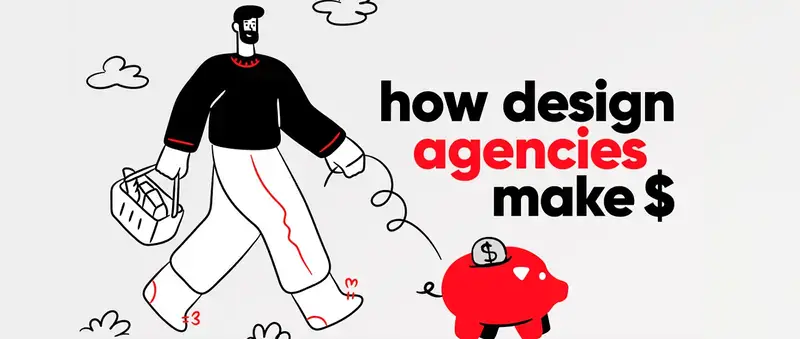
4. Dealing with scope creep
Scope creep – the silent deadline killer. A few “small” client requests here, a minor revision there, and suddenly, your well-planned timeline is in pieces. What seems like an innocent addition can trigger a domino effect, impacting multiple aspects of the project. While some level of change is always expected, letting scope creep spiral unchecked is a sure recipe for chaos.
But what can you do to handle it?
Practice immediate, firm, and transparent communication. When a client requests additions, make it crystal clear that these changes require extra time, resources, and often, a revised deadline.
Instead of instantly agreeing, play it out as a strategic decision where the client is also involved:
- Show them what the impact on the current timeline will be.
- Offer alternatives. What if this is a feature we add as phase two of the project?
- Ultimately, renegotiate the deadlines when and where it’s necessary.
This isn’t about who’s the boss or having it your way at any cost – it’s about trying to do your work the best way possible while protecting your team and the company’s image. Clients will respect your professionalism when you set realistic boundaries from the start.
5. Staying flexible without losing control
Deadlines shift and priorities evolve. Fighting change is useless – embracing it is what sets great project managers apart.
Adaptability isn’t saying yes to everything, though. It means making smart adjustments when needed without compromising on quality or burning out the project team. The key here is knowing when to accept a request and when to refuse it. If a last-minute change is doable, then do it; if it threatens the project’s success, hold your ground and skip it.
Flexibility is a praisable quality, but it shouldn’t come at the cost of your team’s well-being. Clients who know they can stretch your limits will keep doing so, so define them clearly to ensure adaptability doesn’t turn into exploitation.
6. Don’t race the deadline, beat it
Deadlines aren’t your guidelines – they’re the absolute latest moment something should be done. So it’s best to aim to finish early, not just on time. If you succeed, you get room for final reviews, quality checks, and last-minute tweaks, ensuring a stress-free delivery.
With that said, be strategic about early submissions. While some of your clients will appreciate it, others will probably start expecting it every time. If a deadline was agreed upon, it’s probably better to try and stick to it rather than constantly over-deliver projects, or at least choose wisely who you practice it with. Work smart, finish strong, and always stay in control of the clock.
Bottom line
Mastering meeting deadlines isn’t about working faster – it’s about working smarter. From the careful pre-planning to the adaptive execution, every step shapes how smoothly (or chaotically) a project unfolds.
A well-handled deadline boosts your credibility, maintains team morale, and builds client trust. A missed one? Well, that’s a costly mistake. The secret lies in clarity, communication, and control – get these right, and deadlines won’t feel like a race against time, but a timeline you own.
Interested in the best project management tools for tracking progress and deadlines while saving time? I’ve got the right article for you – 22 Best Project Management Software For Creative Agency.
You can also check out our other articles, full of insightful and helpful advice:
- How to Tell a Client “This Is Out of Scope” Without Burning Bridges
- How to Manage a Creative Team – Effective Strategies For Every Situation
- 14 Best Creative Agency Employee Time Tracking Software Tools in 2025
- How to Integrate AI in Project Management Effectively [Tips & Uses]
- How to Manage Client Expectations with Confidence and Clarity
- How to Get Clients to Pay on Time: 10 Golden Techniques


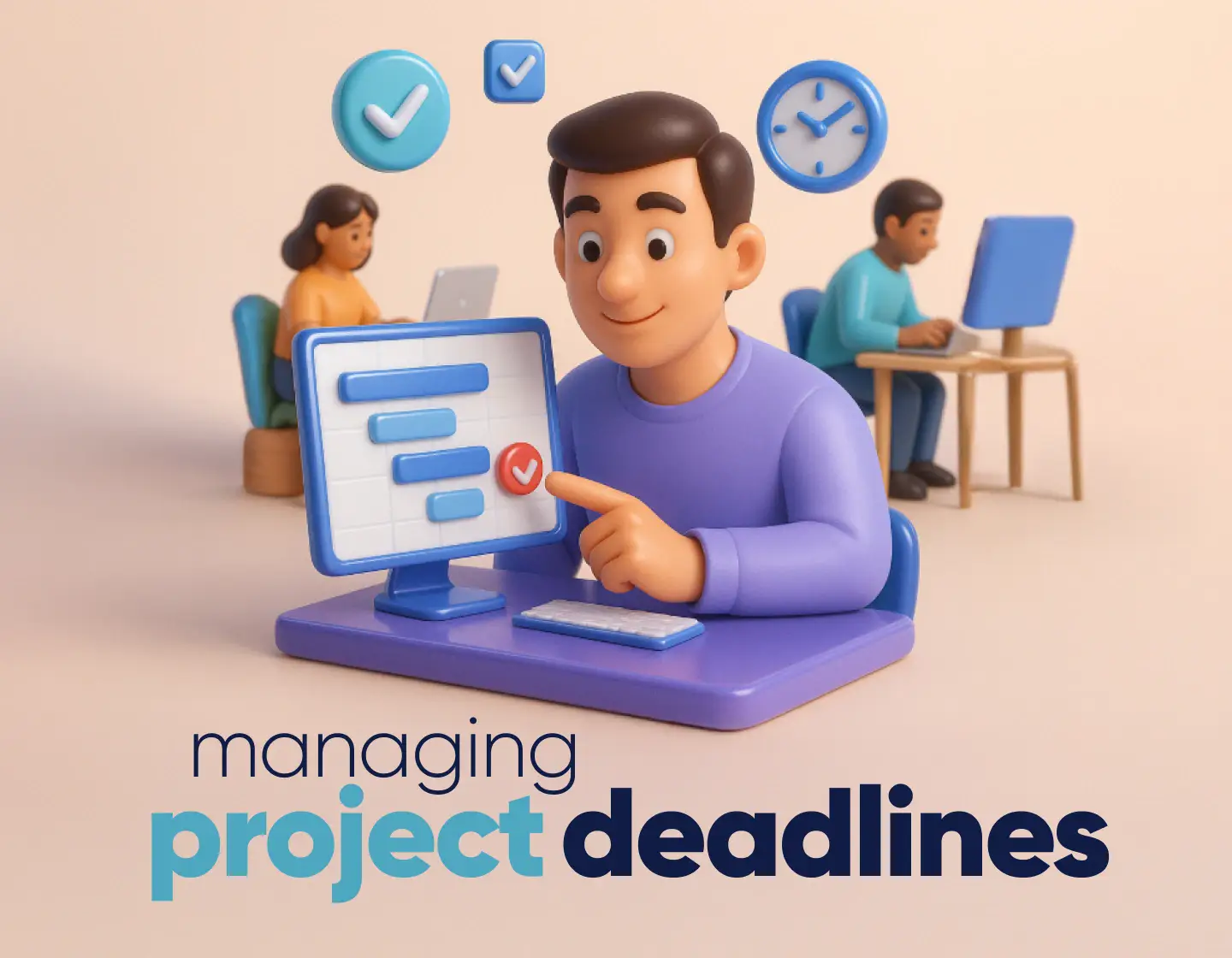
![15 Tips for Effective Communication With Clients [That Actually Work]](https://reallygooddesigns.com/wp-content/uploads/2025/04/tips_for_effective_communication_with_clients-193x150.webp)



